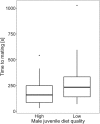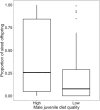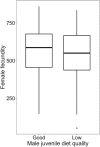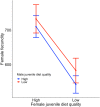Juvenile diet quality and intensity of sexual conflict in the mite Sancassania berlesei
- PMID: 32164531
- PMCID: PMC7069193
- DOI: 10.1186/s12862-020-1599-5
Juvenile diet quality and intensity of sexual conflict in the mite Sancassania berlesei
Abstract
Background: Differing evolutionary interests of males and females may result in sexual conflict, whereby traits or behaviours that are beneficial for male reproductive success (e.g., traits related to male-male competition) are costly for females. Since sexual conflict may play an important role in areas such as speciation, population persistence or evolution of life history traits, understanding what factors modulate the intensity of sexual conflict is important. This study aims to examine juvenile diet quality as one of the underestimated ecological factors that may affect the intensity of sexual conflict via individual conditions. I used food manipulation during the development of the mite Sancassania berlesei to investigate the effects on male reproductive behaviour and competitiveness, male-induced harm to female fitness and female resistance to this harm.
Results: Males that were exposed to low-quality food started mating later than the control males, and number of their mating attempts were lower compared to those of control males. Moreover, males from the low-quality diet treatment sired fewer offspring under competition than males from the control treatment. However, the fitness of females exposed to males reared on a poor diet did not differ from that of females mated with control males. Furthermore, female diet quality did not alter their resistance to male-induced harm.
Conclusion: Overall, diet quality manipulation affected male reproductive behaviour and mating success. However, I found no evidence that the intensity of sexual conflict in S. berlesei depends on male or female conditions. Investigating a broader range of environmental factors will provide a better understanding of sexual conflict dynamics and its feedback into associated evolutionary mechanisms.
Keywords: Behavioural ecology; Condition dependence; Diet quality; Male-induced harm; Male-male competition; Sancassania berlesei; Sexual conflict.
Conflict of interest statement
The author declares that she has no competing interests.
Figures









Similar articles
-
Effects of temperature on the life-history traits of Sancassania (Caloglyphus) berlesei (Acari: Astigmatina: Acaridae) feeding on root-knot nematodes, Meloidogyne spp. (Nematoda: Meloidogynidae).Exp Appl Acarol. 2014 Nov;64(3):299-307. doi: 10.1007/s10493-014-9826-7. Epub 2014 Jun 13. Exp Appl Acarol. 2014. PMID: 24923664
-
An integrative view of sexual selection in Tribolium flour beetles.Biol Rev Camb Philos Soc. 2008 May;83(2):151-71. doi: 10.1111/j.1469-185X.2008.00037.x. Biol Rev Camb Philos Soc. 2008. PMID: 18429767 Review.
-
The evolution of sex peptide: sexual conflict, cooperation, and coevolution.Biol Rev Camb Philos Soc. 2022 Aug;97(4):1426-1448. doi: 10.1111/brv.12849. Epub 2022 Mar 6. Biol Rev Camb Philos Soc. 2022. PMID: 35249265 Free PMC article.
-
Sexual conflict and speciation.Philos Trans R Soc Lond B Biol Sci. 1998 Feb 28;353(1366):261-74. doi: 10.1098/rstb.1998.0208. Philos Trans R Soc Lond B Biol Sci. 1998. PMID: 9533125 Free PMC article. Review.
-
No evidence for reproductive isolation through sexual conflict in the bulb mite Rhizoglyphus robini.PLoS One. 2013 Sep 19;8(9):e74971. doi: 10.1371/journal.pone.0074971. eCollection 2013. PLoS One. 2013. PMID: 24069369 Free PMC article.
Cited by
-
Sexual conflict in a changing environment.Biol Rev Camb Philos Soc. 2021 Oct;96(5):1854-1867. doi: 10.1111/brv.12728. Epub 2021 May 7. Biol Rev Camb Philos Soc. 2021. PMID: 33960630 Free PMC article.
References
-
- Arnqvist G, Rowe L. Sexual conflict. Princeton: Princeton University Press; 2005.
-
- Parker GA. Sexual selection and sexual conflict. In: M.S Blum, N.A Blum, editors. Sexual Selection and Reproductive Competition in Insects. New York: Academic Press; 1979. p. 123–66.
-
- Clutton-Brock TH, Parker GA. Sexual coercion in animal societies. Anim Behav. 1995;49:1345–1365. doi: 10.1006/anbe.1995.0166. - DOI
Publication types
MeSH terms
LinkOut - more resources
Full Text Sources

